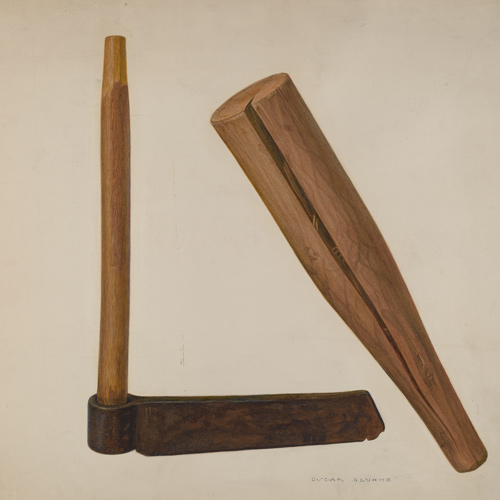The etymology of this unusual word is too vague to recount here, but one form or another—frower, frow, fromward, frommard, etc.—has been in the woodworker’s lexicon since at least the latter half of the 16th century. It was especially common in the U.S. throughout the 19th century, and is still known to most professional carpenters. Basically, it denotes a tool consisting of a blade about 2″ to 3″ wide, 7″ to 12″ or more in length, and from ¼” to 3/8″ in thickness. One end is bent into an eye to receive a 48″ wooden haft (handle); the upper corner of the opposite end is bevelled. The froe is used for cleaving or riving planks, shingles, and slats or laths from clear, solid logs, for use in the construction of dwellings and furniture.
A froe is used first to square up a log by removing four successive segments of the circumference. The blade is carefully placed across the end of the standing log and tapped with light, evenly spaced strokes of a wooden mallet until the blade is fully embedded in the log. The riving continues with mallet strokes against the exposed, beveled end of the blade, accompanied by twisting pressure with the hand holding the haft. When planks are needed, successively larger wooden wedges may be inserted into the rift to facilitate continued splitting as the blade is driven down the log.
From the fact that Israel Whelan, the U.S. Army’s Purveyor of Public Supplies in Philadelphia, purchased two “shingling hatchets” for the expedition, it is clear that Lewis anticipated the construction of log fortifications for their winter garrisons, but there is no evidence that he ordered any froes. Nevertheless, they must have carried at least one, for we know they made a futile attempt to rive cottonwood logs for puncheons (boards) to roof their huts at Fort Mandan. Sgt. Ordway wrote, on 8 November 1804: “[W]e found that the C. W. [cottonwood] will rive well So that we are in hopes to make enofe to cover our buildings but afterwards found it difficult and Gave up the idea.” Their dilemma was inevitable; cottonwood splits poorly because of its uneven, stringy, sometimes curly grain. Nevertheless, they must have taken at least one froe along when they headed west in the spring, since a list of supplies in the Elkskin-bound journal for December 7—the day Clark and his party paddled from Tongue Point to “Lewis’s Bay”—lists 1 “Frow” and 1 “malet,” without further remarks.
The native people who had lived along the Pacific Coast for thousands of years had evolved a technology that enabled the construction of “plank houses” without the need of metal tools such as froes. Lewis encountered the evidence of that, having noticed the very hard wood of the Oregon crab apple tree, Malus fusca (Rafinesque), and observed how the natives used it:
[T]he natives make great uce of it to form their wedges with which they split their boards of [western redcedar] for the purpose of building houses. these wedges they also employ in spliting their firewood and in hollowing out their canoes. I have seen the natives drive the wedges of this wood into solid dry [redcedar] which it cleft without fracturing or injuring the wedge in the smallest degree.
He continued: “[W]e have also found this wood usefull to us for ax handles as well as glutts [gluts] or wedges.”

